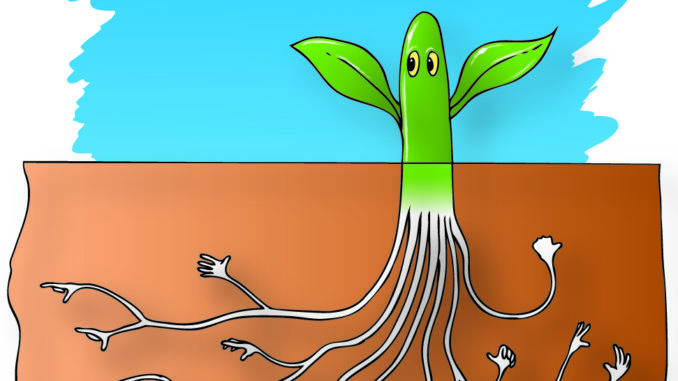
By R. Gary Raham, nature writer and illustrator
Some day just watering and fertilizing a garden may not be enough. The successful gardener might have to become a kind of horticultural trainer, utilizing knowledge about plant behavior to keep all the flowers and veggies happy and healthy. Plants behave? Yes, though not quite with the speed or panache of animals. Plants may look like green stick-in-the-muds, but they do move in response to light and gravity, send chemical messages to each other, and now, some researchers contend, demonstrate a kind of swarm intelligence.
Biologists have described swarm intelligence in creatures like bees and ants. Basically, good decisions can arise through social consensus without any individual ant or bee knowing exactly what’s going on—not terribly unlike some political rallies or homeowner’s associations.
Bees, for example, select new hives using this technique. Thousands of honeybees will take off with a new queen and temporarily cluster at some spot while experienced foragers set off as scouts, looking for a suitable den. When scouts find something promising they return to the group and perform a figure 8 dance. The speed of the dance indicates enthusiasm for the site, the number of “waggles” in the middle of the performance shows distance, and the angle of the dance relative to vertical shows which direction to fly. The speedier dancers enlist more scouts to verify the find. Half a dozen or more groups may be sending out scout patrols at first, but the bees tend to collect around scouts who perform the most frenetically. Less excited scouts eventually give in. (This differs from some human meetings where no one is willing to concede.) When everyone’s dancing the same jig, the swarm moves to its new home—which is almost always the best choice.
A German researcher, Frantisek Baluska, and colleagues believe that plant roots may act with a similar group consensus. In a paper published in the December 2010 issue of Trends in Ecology and Evolution they describe work done with winter rye. One rye plant possessed 13,815,672 roots—plenty for a healthy quorum. Baluska says, “Growing root apices show complex behavior based on ‘intelligent’ decisions about their growth directions. Moreover, growing roots show coordinated group behavior that allows them to exploit the soil resources optimally.”
Baluska outlines three possible mechanisms for this plant behavior: some kind of neural-like network within plant tissues, secreted or evaporated chemicals, or electric fields generated within the roots. The group has leaned toward the concept of nerve-like electrical impulses because of the speed of root responses, but this has generated criticism from other scientists.
Whatever the mechanism, Baluska claims that each root tip acquires information at least partly independently that is then processed along with information from other roots to affect where and how the roots grow. This qualifies as a kind of swarm intelligence, in his view. Plants can thus exploit nutrient bonanzas they encounter in the soil. Susan Milius in a Science News article says, “In earlier experiments dividing a plant’s roots between two pots, the segment in a private pot still shows a response if its counterparts in another container meet some nutrient-sucking intruder.”
Anthony Trewavas of the University of Edinburgh freely uses the phrase ‘plant intelligence’ as a way to describe plants’ abilities to solve the problems of their existence. David G. Robinson of the University of Heidelberg in Germany said, “I see no reason why one can’t simply talk about signal transduction in plants.” He challenges plant neurobiologists to train plants to do something like bend toward a yellow light or avoid a blue one. “My guess is that neither experiment would work,” he said. He described plant neurobiology as “Absolute rubbish, rubbish!”
All the lively discussion is good for plant science—and an integral part of the scientific process in general. Science progresses through experimentation and repeated verification, followed by eventual acceptance or denial of the original hypothesis. Plants do some amazing things for creatures rooted to one spot, and someday plant scientists may swarm to a consensus as to how the deeds are done.
Support Northern Colorado Journalism
Show your support for North Forty News by helping us produce more content. It's a kind and simple gesture that will help us continue to bring more content to you.
BONUS - Donors get a link in their receipt to sign up for our once-per-week instant text messaging alert. Get your e-copy of North Forty News the moment it is released!
Click to Donate